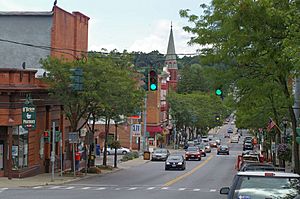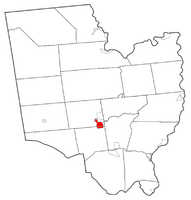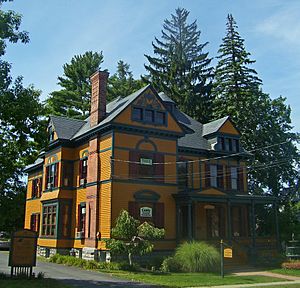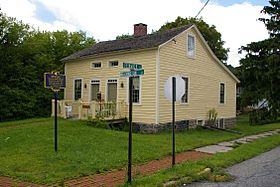Ballston Spa, New York facts for kids
Quick facts for kids
Ballston Spa
|
|
|---|---|
|
Village
|
|
| Village of Ballston Spa | |

Milton Avenue in Ballston Spa
|
|
| Motto(s):
A Village of Friends
|
|

Location within Saratoga County
|
|
| Country | United States |
| State | New York |
| County | Saratoga |
| Settled | 1771 |
| Village | 1807 |
| Named for | Eliphalet Ball |
| Area | |
| • Total | 1.61 sq mi (4.17 km2) |
| • Land | 1.60 sq mi (4.15 km2) |
| • Water | 0.01 sq mi (0.02 km2) |
| Elevation | 315 ft (96 m) |
| Population
(2020)
|
|
| • Total | 5,111 |
| • Density | 3,192.38/sq mi (1,232.93/km2) |
| Time zone | UTC-5 (Eastern (EST)) |
| • Summer (DST) | UTC-4 (EDT) |
| ZIP code |
12020
|
| Area codes | 518 |
| FIPS code | 36-04253 |
| GNIS feature ID | 0969840 |
| Website | www.villageofballstonspa.org |
Ballston Spa is a small village in New York, United States. It is the main town, or county seat, of Saratoga County. You can find it southwest of Saratoga Springs. It's part of a larger area called the Capital Region.
The village is named after Rev. Eliphalet Ball, who was an early settler and a religious leader. In 2020, about 5,111 people lived there. Ballston Spa is special because it sits on the border of two different towns: the Town of Ballston and the Town of Milton. The local school district, which covers a wider area, is often called 'Ballston Spa'. People sometimes call the village itself 'The Village'.
Contents
Discovering Ballston Spa's Past
Ballston Spa was first settled in 1771. This means people started building homes and living there a long time ago. In 1787, a man named Benajah Douglas built the very first hotel and tavern. It was located close to a natural spring.
In 1803, a huge hotel called the Sans Souci Hotel was built. It was the biggest hotel in the United States at that time! Many important people stayed there, including presidents and governors. Ballston Spa officially became a village in 1807.
The village was once famous for its mineral water springs. People believed the water from these springs had healing powers. The water was fizzy and contained minerals like salt, magnesium, and calcium.
Ballston Spa in Movies, Music, and Books
Ballston Spa has inspired many creative works!
Books and Stories
- Parts of the famous novel The Last of the Mohicans were written here by James Fenimore Cooper. The local scenery gave him ideas for his story.
- The village was the setting for the 1993 book and 1994 movie, Nobody's Fool. The author, Richard Russo, grew up nearby.
- It was also mentioned in the book The Angel of Darkness by Caleb Carr. This book featured a fictional murder trial set in Ballston Spa in 1897.
- The 1963 novel The Tulip Tree by Howard Rigsby also mentioned Ballston Spa.
Music and Film
- A folk singer named Buster Red mentioned Ballston Spa in his song "When I Go Out."
- Several scenes from the 1973 movie The Way We Were were filmed on Front Street in Ballston Spa.
- Scenes from The Horse Whisperer (1998) were also filmed in the village.
- Since 2008, Ballston Spa has hosted the Ballston Spa Film Festival. This festival shows short films from all over the world.
Exploring Museums and History
Ballston Spa is home to some interesting museums.
Local Museums
- The National Bottle Museum is located here. It's a unique place where you can learn all about bottles!
- The Brookside Museum is also in Ballston Spa. This museum is run by the Saratoga County Historical Society and shares the history of the area.
Historic Buildings
Several buildings in Ballston Spa are listed on the National Register of Historic Places. This means they are important historical sites. These include the Brookside Museum, the United States Post Office, the Union Mill Complex, and the Verbeck House.

Local Industries and Jobs
Ballston Spa has a history of important businesses.
Banking and Manufacturing
- The Ballston Spa National Bank was started in 1838. It's one of the oldest banks in America that is still open today!
- George West was known as the "Paper Bag King." He invented a way to make square-bottomed paper bags. He owned many paper mills along the Kayaderosseras Creek and made millions of bags.
- The Ballston Knitting Company also operated here for many years, from 1918 to 1994.
County Government
Because Ballston Spa is the county seat of Saratoga County, many people work for the county government. This includes offices, courts, law enforcement, and the jail. These jobs are a big part of the local economy.
Famous People from Ballston Spa
Many notable people have connections to Ballston Spa.
- Abner Doubleday, a hero from the American Civil War, was born here. Some people even say he invented baseball! His birthplace is a New York State landmark.
- General James Gordon, who fought in the American Revolution, lived in Ballston Spa. Gordon Creek is named after him.
- Trevor Marsicano is an Olympic speedskater who won a silver medal in 2010.
- Frances Shimer founded Shimer College.
- Ira Thomas was a Major League Baseball player born in Ballston Spa.
- Stephen Trombley is an Emmy Award-winning filmmaker, author, and musician who graduated from Ballston Spa High School.
- Todd Waring is a television and movie actor who also graduated from Ballston Spa High School.
- George West, the "Paper Bag King," was also a member of the New York State Assembly and the United States Congress.
Geography and Location
Ballston Spa is located at 43°0′26″N 73°51′4″W / 43.00722°N 73.85111°W.
The village covers about 1.6 square miles (4.1 square kilometers) of land. Only a very small part of it is water.
Roads and Highways
- New York State Route 50 (Milton Avenue) goes through the village from north to south.
- It crosses with New York State Route 67 (West High Street).
- County Road 63 (Malta Avenue) leaves the village to the east. It connects to major highways like U.S. Route 9 and Interstate 87.
Population and People
| Historical population | |||
|---|---|---|---|
| Census | Pop. | %± | |
| 1810 | 500 | — | |
| 1840 | 1,500 | — | |
| 1850 | 2,000 | 33.3% | |
| 1860 | 2,285 | 14.3% | |
| 1870 | 2,970 | 30.0% | |
| 1880 | 3,011 | 1.4% | |
| 1890 | 3,527 | 17.1% | |
| 1900 | 3,923 | 11.2% | |
| 1910 | 4,138 | 5.5% | |
| 1920 | 4,103 | −0.8% | |
| 1930 | 4,591 | 11.9% | |
| 1940 | 4,434 | −3.4% | |
| 1950 | 4,937 | 11.3% | |
| 1960 | 4,991 | 1.1% | |
| 1970 | 4,968 | −0.5% | |
| 1980 | 4,711 | −5.2% | |
| 1990 | 4,937 | 4.8% | |
| 2000 | 5,556 | 12.5% | |
| 2010 | 5,409 | −2.6% | |
| 2020 | 5,111 | −5.5% | |
| U.S. Decennial Census | |||
In 2020, there were 5,111 people living in Ballston Spa. There were 2,291 households. Most people in the village are White (96.33%). There are also smaller groups of African American, Native American, and Asian residents. About 1.94% of the population is Hispanic or Latino.
The average age of people in Ballston Spa is 36 years old. About 23.9% of the population is under 18 years old.
Schools in Ballston Spa
Ballston Spa has several schools for students of all ages.
Public Schools
The Ballston Spa Central School District serves the area. Here are some of the public schools:
- Milton Terrace Elementary School
- Wood Road Elementary School
- Malta Avenue Elementary School
- Ballston Spa Middle School
- Ballston Spa High School
- Gordon Creek Elementary School (opened in 2013)
Private Schools
There are also private school options:
- St. Mary's is a Catholic school for preschool through 5th grade.
- Spa Christian School is a small, private Christian school for children from Pre-K to 6th grade.
- The Church Mouse is a Christian preschool and pre-K.
Climate and Weather
Ballston Spa has a climate with big changes between seasons. Summers are warm to hot and often humid. Winters are cold, sometimes very cold. This type of climate is called a humid continental climate.
See also
 In Spanish: Ballston Spa para niños
In Spanish: Ballston Spa para niños




